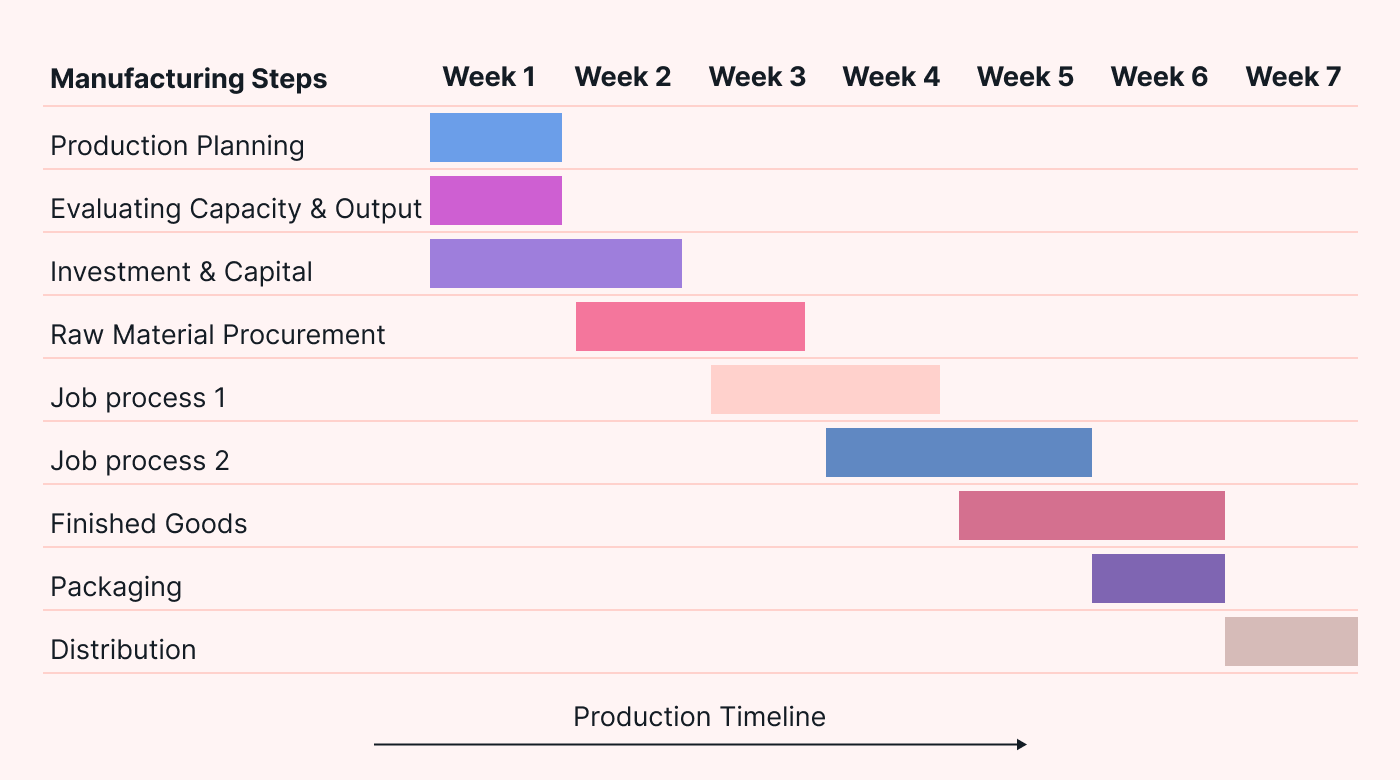Production and manufacturing are fast-paced. You have to stock the suitable materials, have the right processes in place, and ensure you’re working as efficiently as possible to get the job done.
But when your production line is growing and new orders are flying through the door, you need a system to keep on top of everything.
This is where material requirements planning (MRP) can help.
In this article, we’ll show you the MRP process and how it’s grown into manufacturing resource planning. We’ll also show you the benefits of using MRP, examples, and what features to look out for in your own MRP system.
What does MRP mean?
MRP stands for material requirements planning. It helps businesses plan, track, and manage their materials throughout the manufacturing process.
MRP systems analyze factors such as production schedules, lead times, inventory levels, and demand forecasts. They use this information to generate accurate material requirements. As a result, you can make sure you have the right materials, in the right quantities, at the right time.
It also helps you optimize the production process, bringing any hurdles or bottlenecks to light. Then, you can identify the cause of the problem and make changes to streamline the flow of work. You can also minimize inventory costs, reduce stockouts, and improve overall production efficiency.
The evolution of MRP-I to MRP-II
MRP has evolved over the years. The first version (which we’ve just described) is known as MRP-I. It began around 1965 when the first commercial computers became available. Since then, it’s evolved into manufacturing resource planning or MRP-II.
Compared to MRP-I, manufacturing resource planning is much more sophisticated. The exact functionalities vary depending on the software. Typically speaking, it can create the following:
- Capacity plans
- Resource schedules
- Work progress reports
- Sales order processing
- Cost accounting data
- Batching rules
These additional features (and these are just to name a few) give you access to advanced planning techniques. As a result, you can develop a more detailed production schedule.
MRP-II also provides access to real-time data for managing your resources.
You can coordinate labor availability, plan material delivery, review your workstation capacity, and more. This means you get a clear overview of all the resources used in your manufacturing process, how to allocate them effectively, and how to optimize your production flow.
Most of today’s MRP systems are based on MRP II. Why? Because it’s versatile, advanced, and can be used by itself or as a core part of a manufacturing enterprise resource planning (ERP) system — which leads us nicely to our next section.
What’s the difference between MRP and ERP?
MRP and ERP are related, but they manage different aspects of business operations.
Here’s an overview:
 |
Now let’s break it down.
MRP is a specialized system for managing manufacturing processes and material requirements. It helps you identify what resources you need, when you need them, and how to use them effectively and efficiently.
ERP is a bit more comprehensive. An ERP system integrates all aspects of a business into one unified platform (including MRP functionalities). It also goes beyond manufacturing. It covers various business functions, such as business intelligence, customer relationship management, and accounting, making it an ideal platform for creating seamless and efficient operations across your business.
What are the benefits of MRP?
Take a look at some of the benefits of using MRP.
- To improve inventory management. MRP helps businesses optimize their inventory levels. How? By making sure that you have the suitable materials available at the right time. It considers factors such as lead times, production schedules, and demand forecasts to minimize inventory carrying costs. Plus, all of this helps you avoid stockouts and production delays.
- To effectively plan and schedule production. With an MRP system, you can accurately predict the quantities and timing of the materials you need for production. This helps you plan your manufacturing processes and schedule production orders based on customer demand and available inventory.
- To streamline resource allocation. MRP systems allocate resources in line with material availability and production schedules. This prevents bottlenecks and helps you maximize your resources, reducing idle time and boosting productivity.
What is an example of MRP?
Let's consider a bicycle manufacturer as an example. For this business, the company needs MRP to plan and manage the materials needed for bike production.
The company uses an MRP system to make sure they have the necessary components and materials to produce their bikes. Using MRP software, they input various parameters to help them track this information. This includes customer orders, production schedules, current inventory levels, and lead times for obtaining materials.
Based on this information, the MRP system generates a detailed plan outlining the quantities and timings for material purchases or production orders. Then, it helps them track and plan quantities to meet customer demand while minimizing inventory costs.
Features to look out for in your own MRP system
If you’re thinking about using an MRP system, have a read through some of these key features to look out for.
Ease of use
An MRP system that’s easy to use will make the entire material planning process easier to manage.
Think about it. If you’re using a tricky and complex platform, it’ll be harder to visualize the critical production information. But with a simple interface, you can easily see which materials you need, where the customer demand is, and manage your stock inventory.
Here are some of the simple features that’ll make an MRP system easier to use.
- Simple interface. A visually appealing and simple interface will make it easier for you and your team to navigate the platform. As a result, you can manage your materials and resources more efficiently.
- Collaborative. The production process rarely involves one person. Chances are, you’ll need to collaborate with team members to make sure everything’s running smoothly. With a collaborative MRP system, keeping in touch with colleagues and ensuring you’re ordering suitable materials at the right time is easy.
- Customizable. Not every production process is the same, so customization is an important feature to look out for in MRP software. With customizable features, you can create a production line that accurately reflects your business needs, giving you the best chance of success.
Visualize production timeframes
An MRP system should help you visualize timeframes in your manufacturing processes. For example, how long it takes to produce goods, when resources should be made available, and how to avoid bottlenecks in a product’s routing.
Here’s how it should look:
 |
If you don’t know how long certain parts of your production process take to complete, you could delay or hinder the assembly of your product. You might over-order materials, cause backlogs in your production, or create bottlenecks in your flow of work.
That’s why it’s vital that you understand and visualize your entire production time frame. You need to know how long different parts of your production process take to complete so you can accurately estimate materials and allocate resources.
Create a detailed master production schedule (MPS)
A master production schedule (MPS) outlines the production quantities and schedules for finished products. It’s usually based on sales forecasts, customer orders, and inventory levels.
An MPS is included in most MRP software, but it’s important to discuss it nonetheless.
Why? Because this schedule is a critical component of the manufacturing planning process.
It translates the overall demand forecast into a detailed production schedule, ensuring you’re efficiently organizing your resources and ordering suitable materials. It also aligns different departments, allowing teams to collaborate and allocate resources effectively throughout the business.
Plus, it prevents overproduction, reduces your carrying costs, and minimizes bottlenecks — all of which help you create a more effective production process.
Access to real-time data
You need access to real-time data. It allows you to coordinate labor availability, schedule material delivery, plan routings, and access workstation capacity — all with the most up-to-date information.
You could be working with out-of-date data if you don’t have real-time access. As a result, you might find yourself ordering items you don’t need, missing items from the production schedule, or generally planning work that isn’t as efficient as it could be.
Plus, access to instant data also helps you forecast demand in real time. You can see what your customers are ordering and act fast to deliver the goods as quickly as possible. This means they get a better experience, and you are working more efficiently. It’s a win-win.
Calculate your net requirements
Net requirements are the additional quantities needed to fulfill the production schedule. It takes into account the existing inventory and open purchase orders.
Here’s how the formula works:
 |
When it comes to an MRP system, you want a platform that automatically calculates your net requirements. Then, if your inventory doesn’t meet demand, the MRP system can step in and order the items you need.
That way, you don’t have to worry about manually keeping on top of materials when demand increases. It frees up time to focus on other tasks and ensures you order items as and when needed.
Map your bill of materials (BOM)
The bill of materials (BOM) is a comprehensive list of all the raw materials, components, and sub-assemblies you need to manufacture each of your products. It also specifies the quantity of each material for one finished product.
Here’s why it’s so important to have a BOM in your MRP platform:
- To understand how materials relate to each other. A BOM outlines the structure of a product, detailing its components and sub-assemblies. This helps you visualize what materials you need and understand the relationships between parts and assemblies. This is essential for calculating precise material requirements, ensuring you have the right quantities at each production stage.
- To calculate your lead time. BOMs help you understand the lead times between materials and assembly. For example, you can see how long it takes for a material to arrive and how long it takes to incorporate it into the product build. This helps you set realistic delivery dates for customers and make informed decisions about production scheduling.
- To have a backup plan. An MRP platform that supports BOM creation can help you run various production scenarios and simulations. For instance, you can assess the impact of changes in demand, production capacity, or resource availability. This helps you strategically optimize your production schedule and allocate resources.
As with MPS, most MRP platforms will allow you to create a bill of materials. But it’s important to double-check and ensure you have access to this feature.
Use Motion to plan your materials and allocate resources
MRP is important for any business with a production line. With an effective MRP solution in place, you can reduce costs, save time, and make your production workflow more efficient. As a result, you’ll be able to deliver a better experience to your customers and help your business grow.
But if you’re thinking, “MRP sounds like a lot of work,” — don’t worry. You can streamline the process by using an online work management tool like Motion. With Motion, you can easily plan, manage, and track all the MRP activities in one location.
You can access tasks in real-time, share updates with your team, and quickly reschedule items. The AI-powered calendar handles the reshuffling of your tasks, taking top-priority items into account and updating the rest of your schedule accordingly.
Sign up for a free trial to see how it works.





